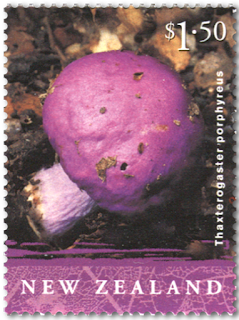Unique, essential, extravagant - our native fungi are truly remarkable. They come in an astonishing array of shapes and vivid, even extravagant, colours. Surprisingly, they are not part of the plant kingdom. In fact, in some respects, they have more in common with animals. Their structure is so unique that scientists now put fungi in a kingdom all of their own.
Fungi are essential to the ecosystem of our forests and bush. They decompose dead plant or animal material and recycle minerals locked up in organic material that trees and plants could not otherwise absorb.
The Six Stamps.
40c - Hygrocybe Rubrocarnosa.
One of the most vivid and eerily beautiful of our native fungi, in a classic toadstool shape, generally found in autumn in mixed forests around Auckland, Waikato, Bay of Plenty and Wellington.
80c - Entoloma Hochstetteri.
This striking blue mushroom type fungus is found in soil, moss and on rotting wood, generally in autumn, right around the country. This species can vary from a very bright blue to duller shades.
90c - Aseroe Rubra.
Looking more like a sea anemone, with its waving Medusa-like petals, this is actually a scarlet flower fungus. Its spores are produced in the slimy mucus located in the centre. Found from February to May in beech and mixed forests' leaf litter.
$1.30 - Hericium Coralloides.
An icicle fungus, much-branched with many spines from each branch that are soft to the touch when young. Found through autumn and early winter in South Auckland, Waikato, Bay of Plenty, Taranaki, Wellington and Nelson.
$1.50 - Thaxterogaster Porphyreus.
Of the mushroom types of fungi, this variety is something of an anomaly. Instead of dispersing its spores aerially by opening its cap, it attracts insects and probably birds which feed on the cap, consume the spores and distribute them through their wastes.
$2.00 - Ramaria Aureorhiza.
A 'coral' fungi. These are related to the mushrooms, but produce spores over the whole surface of the fruiting body instead of solely on the gills under the cap. Found mainly in the Waikato and Whanganui areas.
Collectable Stamp Items.
First Day Covers and a Miniature Sheet Bursting with Nature's Creativity
From the extraordinary diversoty of fungi - puffballs, jelly fungi, paint fungi, cups, brackets and more - we selected six New Zealand natives to feature in this issue. Assembled together on the first-day covers and miniature sheets, they created a brilliant display of nature's creativity.
First Day Cover - 6 March 2002.
Miniature Sheet with one 40c, one 80c, one 90c, one $1.30, one $1.50 and one $2.00 stamp.
Miniature Sheet First Day Cover - 6 March 2002.
Limited Edition
Limited edition collectable containing exclusive stamp products not available anywhere else.
The limited-edition presentation for this stamp issue that was strictly limited to 2,000 copies. It included a full set of stamps, a fascinating booklet filled with interesting facts about the issue and six stamp plate blocks. There was also a signed souvenir first-day cover and a unique stamp product. This unique product for the New Zealand's Native Fungi issue was a miniature sheet that featured all six stamps, individually numbered in gold.
Technical Information.
Date of issue: 6 March 2002.
The number of stamps: Six.
Denominations and designs: 40c Hygrocybe rubrocarnosa, 80c Entoloma hochstetteri, 90c Aseroe rubra, $1.30 Hericium coralloides, $1.50 Thaxterogaster porphyreus, $2.00 Ramaria aureorhiza.
Stamps and first-day cover designed: DNA Design, Wellington.
Printer and process: Southern Colour Print, Dunedin by offset lithography.
The number of colours: our process colours
Stamp size and format: 30mm x 40mm (vertical).
Paper type: De la Rue 103gsm red phosphor stamp paper.
Perforation gauge: 14.
The number of stamps per sheet: 25.
Period of sale: These stamps remained on sale until 5 March 2003.
Some of the images in this post were used with permission from the illustrated catalogue of StampsNZ
You can visit their website and Online Catalogue at, http://stampsnz.com/
Information & images for this post came from.











We appreciate your engagement with our content. To ensure a respectful and constructive community, please take note of the following:
- No Spam, Please: We do not tolerate spammy or promotional comments. Any such comments will be promptly removed.
- Moderation in Place: All comments are moderated to maintain a positive and inclusive environment. Please be patient, as it may take a little time for your comment to appear.
- Sign In with Google: To comment, please sign in using your Google account. This helps us maintain the integrity of our community and allows for better interaction.